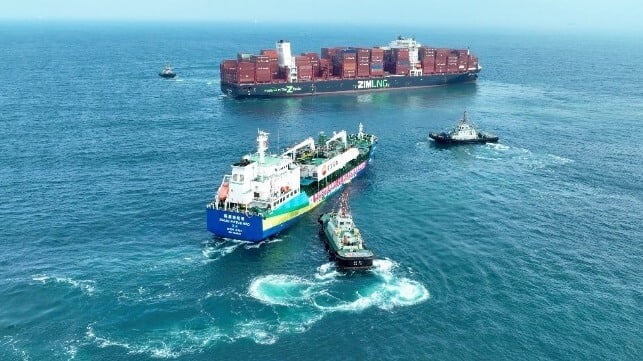Hong Kong Launches Ship-to-Ship LNG Bunkering Operation

Officials in Hong Kong are hailing the launch of bunkering operations to fuel LNG ships. It provides another competitive tool for the port which along with other major ports in the region including Singapore and Shanghai are offering LNG bunkering operations.
Kunlun Energy Co., controlled by PetroChina, reported the first official bunkering operation on February 14 taking place in the southern anchorage of Hong Kong’s Cheung Chau. The company’s bunker vessel was positioned alongside the Zim Aquamarine (81,681 dwt) to load 2,200 tons of ultra-low temperature LNG. Using an advanced bunker system, the operation took about seven hours.
The 7,000 TEU vessel was recently delivered from the shipyard and is now in service between the Far East and the Mediterranean. The companies report the refueling in Hong Kong will meet the ship’s fuel requirements for the entire voyage.
The bunkering service will be offered with the company’s vessel. It is equipped with two independent "C"-type cargo tanks with a maximum capacity of 8,500 cubic meters, providing customers with one-stop customized services, including cold storage, degassing, and LNG bunkering.
In late January, a test bunkering was also carried out with a Zim vessel, Zim Amber, another ship of the same class. The service has now been officially inaugurated with Hong Kong port officials reporting the goal is to bunker 200,000 tons of green fuels annually by 2030. According to data provided by PetroChina, by the end of 2024, it had supplied approximately 15.8 billion cubic meters of gas to Hong Kong, with an annual supply of about 1.5 billion cubic meters. Adding ship bunkering is being called another important milestone.
Hong Kong joins as many as 100 bunkering ports worldwide with most major shipping ports now having capabilities to supply LNG. According to the trade group SEA-LNG, the bunkering infrastructure to support LNG as a marine fuel has developed rapidly. It can now be delivered to vessels in some 96 ports, including most of the main bunkering ports, with a further 55 ports in the process of facilitating LNG bunkering investments and operations.
The group highlights the dramatic growth in the LNG bunker fleet. DNV calculates there are 65 supply ships now in service. This compares with just six LNG bunker vessels in 2019. DNV reports that an additional 16 LNG bunker vessels are currently on order. Europe and Asia each have about a third of the LNG bunker fleet, with the Americas third at 17 percent.
Globally there are over 650 LNG-fueled vessels now in service. The size of the fleet is expected to double over the next eight years to 2033.
